000
front-matter
Econometrics of Financial High-Frequency Data
Preface
Contents
001
Chapter 1: Introduction
1.1 Motivation
1.2 Structure of the Book
References
002
Chapter 2: Microstructure Foundations
2.1 The Institutional Framework of Trading
2.1.1 Types of Traders and Forms of Trading
2.1.2 Types of Orders
2.1.3 Market Structures
2.1.3.1 Quote-Driven Dealer Markets
2.1.3.2 Order-Driven Markets
2.1.3.3 Brokered Markets
2.1.4 Order Precedence and Pricing Rules
2.1.5 Trading Forms at Selected International Exchanges
2.1.5.1 The New York Stock Exchange (NYSE)
2.1.5.2 NASDAQ
2.1.5.3 XETRA
2.1.5.4 Australian Stock Exchange
2.2 A Review of Market Microstructure Theory
2.2.1 Asymmetric Information Based Models
2.2.1.1 Sequential Trade Models
2.2.1.2 Strategic Trade Models
2.2.2 Inventory Models
2.2.3 Major Implications for Trading Variables
2.2.4 Models for Limit Order Book Markets
References
003
Chapter 3: Empirical Properties of High-Frequency Data
3.1 Handling High-Frequency Data
3.1.1 Databases and Trading Variables
3.1.2 Matching Trades and Quotes
3.1.3 Data Cleaning
3.1.4 Split-Transactions
3.1.5 Identification of Buyer- and Seller-Initiated Trades
3.2 Aggregation by Trading Events: Financial Durations
3.2.1 Trade and Order Arrival Durations
3.2.2 Price and Volume Durations
3.3 Properties of Financial Durations
3.4 Properties of Trading Characteristics
3.5 Properties of Time Aggregated Data
3.6 Summary of Major Empirical Findings
References
004
Chapter 4: Financial Point Processes
4.1 Basic Concepts of Point Processes
4.1.1 Fundamental Definitions
4.1.1.1 Point Processes
4.1.1.2 Counting Processes
4.1.1.3 Durations and Backward Recurrence Times
4.1.1.4 Filtrations and (Time-Varying) Covariates
4.1.2 Compensators and Intensities
4.1.3 The Homogeneous Poisson Process
4.1.4 Generalizations of Poisson Processes
4.1.5 A Random Time Change Argument
4.1.6 Intensity-Based Inference
4.1.7 Simulation and Diagnostics
4.2 Four Ways to Model Point Processes
4.2.1 Intensity Models
4.2.2 Hazard Models
4.2.2.1 Proportional Hazard (PH) Models
4.2.2.2 Accelerated Failure Time Models
4.2.3 Duration Models
4.2.4 Count Data Models
4.3 Censoring and Time-Varying Covariates
4.3.1 Censoring
4.3.2 Time-Varying Covariates
4.4 An Outlook on Dynamic Extensions
References
005
Chapter 5: Univariate Multiplicative Error Models
5.1 ARMA Models for Log Variables
5.2 A MEM for Durations: The ACD Model
5.3 Estimation of the ACD Model
5.3.1 QML Estimation
5.3.2 ML Estimation
5.4 Seasonalities and Explanatory Variables
5.5 The Log-ACD Model
5.6 Testing the ACD Model
5.6.1 Portmanteau Tests
5.6.2 Independence Tests
5.6.3 Distribution Tests
5.6.4 Lagrange Multiplier Tests
5.6.5 Conditional Moment Tests
5.6.5.1 Adapting Newey's Conditional Moment Test
5.6.5.2 Integrated Conditional Moment Tests
5.6.6 Monte Carlo Evidence
References
006
Chapter 6: Generalized Multiplicative Error Models
6.1 A Class of Augmented ACD Models
6.1.1 Special Cases
6.1.1.1 Additive and Multiplicative ACD (AMACD) Model
6.1.1.2 Box–Cox ACD (BACD) Model
6.1.1.3 EXponential ACD (EXACD) Model
6.1.1.4 Augmented Box–Cox ACD (ABACD) Model
6.1.1.5 Hentschel ACD (HACD) Model
6.1.1.6 Augmented Hentschel ACD (AHACD) Model
6.1.1.7 Spline News Impact ACD (SNIACD) Model
6.1.2 Theoretical Properties
6.1.3 Empirical Illustrations
6.2 Regime-Switching ACD Models
6.2.1 Threshold ACD Models
6.2.2 Smooth Transition ACD Models
6.2.3 Markov Switching ACD Models
6.3 Long Memory ACD Models
6.4 Mixture and Component Multiplicative Error Models
6.4.1 The Stochastic Conditional Duration Model
6.4.2 Stochastic Multiplicative Error Models
6.4.3 Component Multiplicative Error Models
6.5 Further Generalizations of Multiplicative Error Models
6.5.1 Competing Risks ACD Models
6.5.2 Semiparametric ACD Models
6.5.3 Stochastic Volatility Duration Models
References
007
Chapter 7: Vector Multiplicative Error Models
7.1 VMEM Processes
7.1.1 The Basic VMEM Specification
7.1.2 Statistical Inference
7.1.3 Applications
7.2 Stochastic Vector Multiplicative Error Models
7.2.1 Stochastic VMEM Processes
7.2.2 Simulation-Based Inference
7.2.3 Modelling Trading Processes
References
008
Chapter 8: Modelling High-Frequency Volatility
8.1 Intraday Quadratic Variation Measures
8.1.1 Maximum Likelihood Estimation
8.1.2 The Realized Kernel Estimator
8.1.3 The Pre-averaging Estimator
8.1.4 Empirical Evidence
8.1.5 Modelling and Forecasting Intraday Variances
8.2 Spot Variances and Jumps
8.3 Trade-Based Volatility Measures
8.4 Volatility Measurement Using Price Durations
8.5 Modelling Quote Volatility
References
009
Chapter 9: Estimating Market Liquidity
9.1 Simple Spread and Price Impact Measures
9.1.1 Spread Measures
9.1.2 Price Impact Measures
9.2 Volume Based Measures
9.2.1 The VNET Measure
9.2.2 Excess Volume Measures
9.2.2.1 Determinants of Excess Volume Durations
9.2.2.2 Measuring Realized Market Depth
9.3 Modelling Order Book Depth
9.3.1 A Cointegrated VAR Model for Quotes and Depth
9.3.2 A Dynamic Nelson–Siegel Type Order Book Model
9.3.3 A Semiparametric Dynamic Factor Model
References
010
Chapter 10: Semiparametric Dynamic Proportional Hazard Models
10.1 Dynamic Integrated Hazard Processes
10.2 The Semiparametric ACPH Model
10.3 Properties of the Semiparametric ACPH Model
10.3.1 Autocorrelation Structure
10.3.2 Estimation Quality
10.4 Extended SACPH Models
10.4.1 Regime-Switching Baseline Hazard Functions
10.4.2 Censoring
10.4.3 Unobserved Heterogeneity
10.5 Testing the SACPH Model
10.6 Estimating Volatility Using the SACPH Model
10.6.1 Data and the Generation of Price Events
10.6.2 Empirical Findings
References
011
Chapter 11: Univariate Dynamic Intensity Models
11.1 The Autoregressive Conditional Intensity Model
11.2 Generalized ACI Models
11.2.1 Long-Memory ACI Models
11.2.2 An AFT-Type ACI Model
11.2.3 A Component ACI Model
11.2.4 Empirical Application
11.3 Hawkes Processes
References
012
Chapter 12: Multivariate Dynamic Intensity Models
12.1 Multivariate ACI Models
12.2 Applications of Multivariate ACI Models
12.2.1 Estimating Simultaneous Buy/Sell Intensities
12.2.2 Modelling Order Aggressiveness
12.3 Multivariate Hawkes Processes
12.3.1 Statistical Properties
12.3.2 Estimating Multivariate Price Intensities
12.4 Stochastic Conditional Intensity Processes
12.4.1 Model Structure
12.4.2 Probabilistic Properties of the SCI Model
12.4.3 Statistical Inference
12.5 SCI Modelling of Multivariate Price Intensities
References
013
Chapter 13: Autoregressive Discrete Processes and Quote Dynamics
13.1 Univariate Dynamic Count Data Models
13.1.1 Autoregressive Conditional Poisson Models
13.1.2 Extended ACP Models
13.1.3 Empirical Illustrations
13.2 Multivariate ACP Models
13.3 A Simple Model for Transaction Price Dynamics
13.4 Autoregressive Conditional Multinomial Models
13.5 Autoregressive Models for Integer-Valued Variables
13.6 Modelling Ask and Bid Quote Dynamics
13.6.1 Cointegration Models for Ask and Bid Quotes
13.6.2 Decomposing Quote Dynamics
References
014
Appendix A: Important Distributions for Positive-Valued Data
Poisson Distribution
Negative Binomial Distribution
Log-Normal Distribution
Exponential Distribution
Gamma Distribution
Weibull Distribution
Generalized Gamma Distribution
Generalized F Distribution
Burr Distribution
Extreme Value Type I Distribution
Burr Type II Distribution
Pareto Distribution
Index
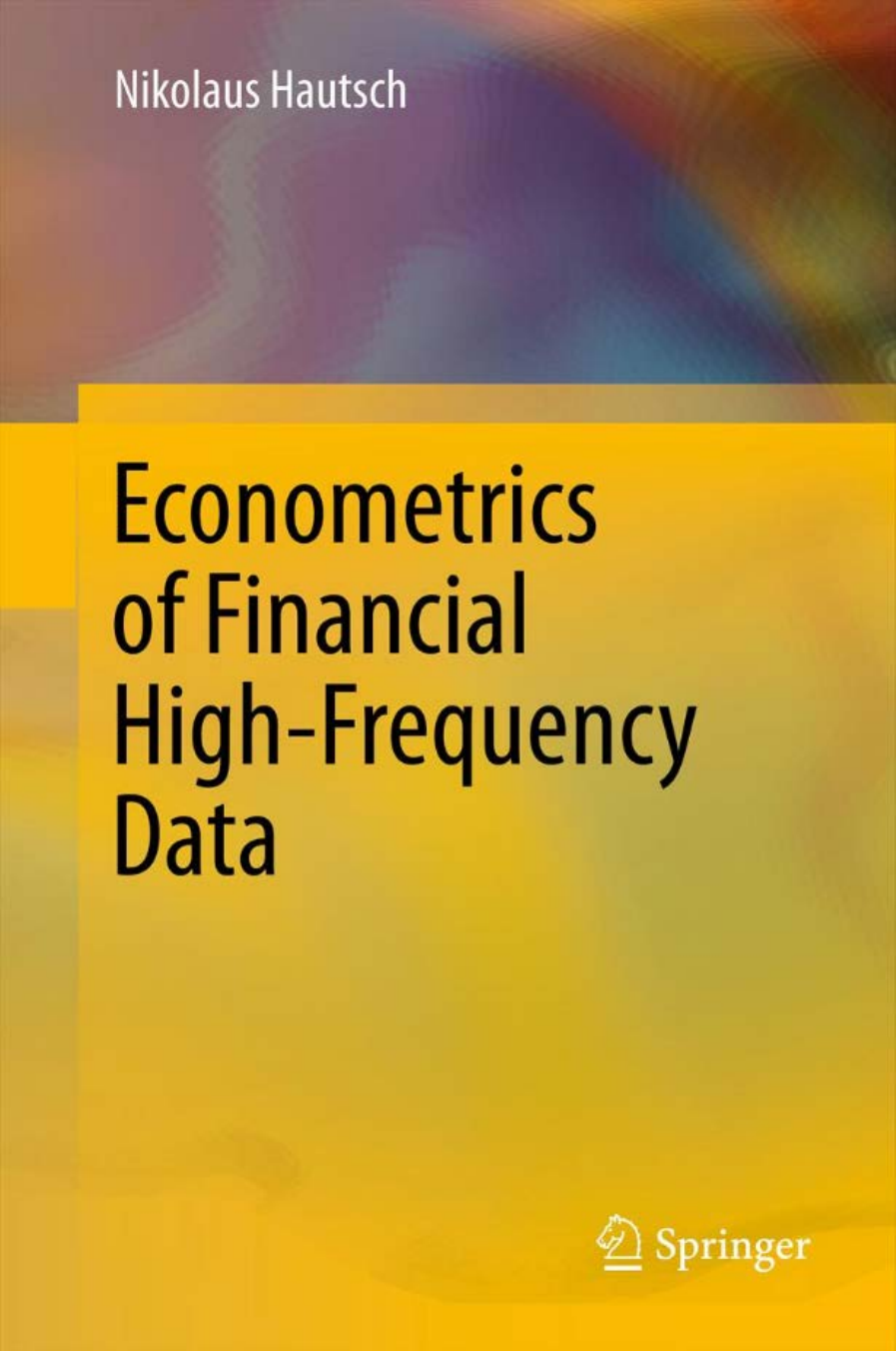
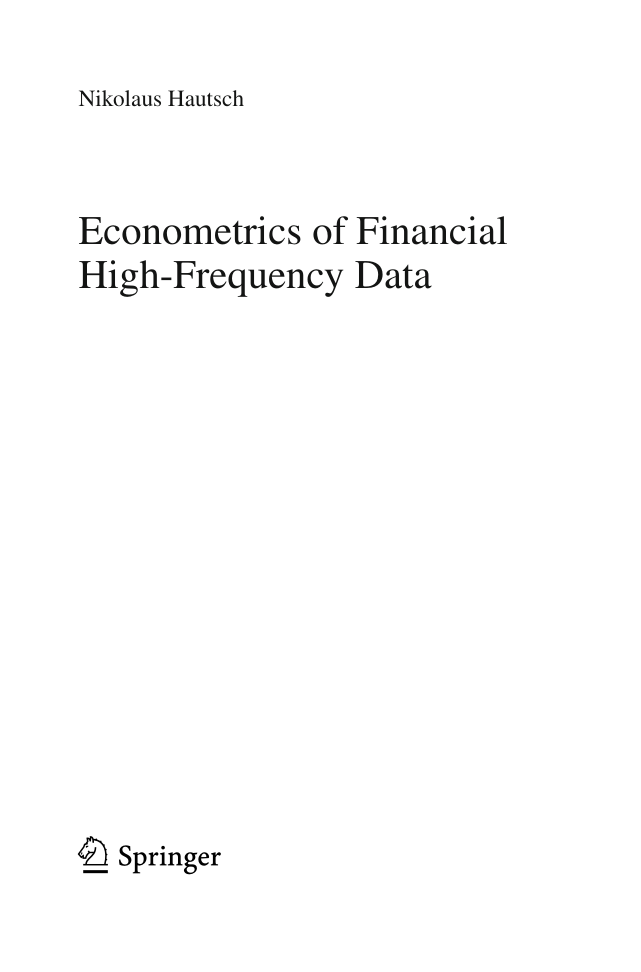


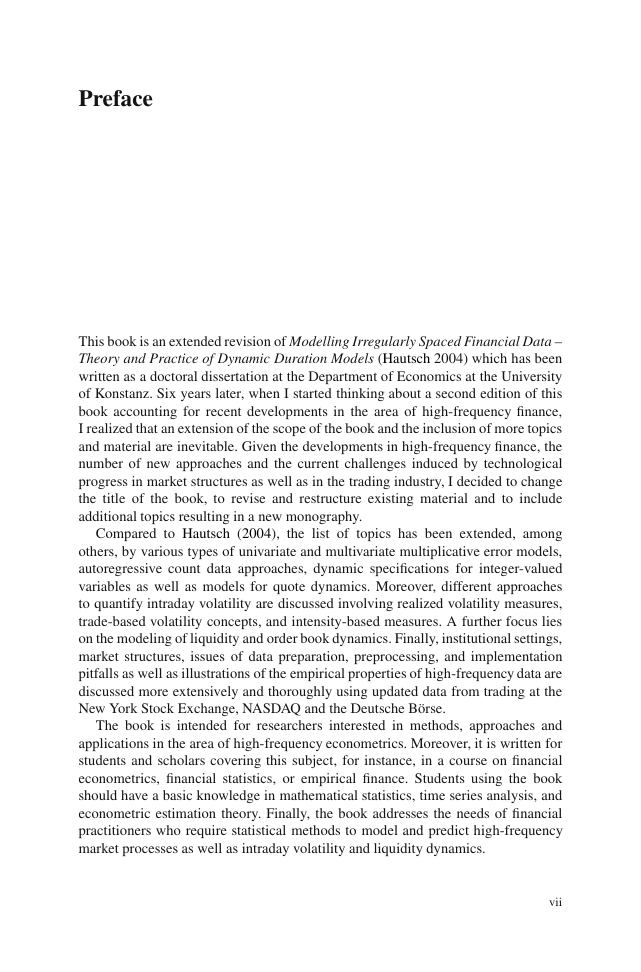
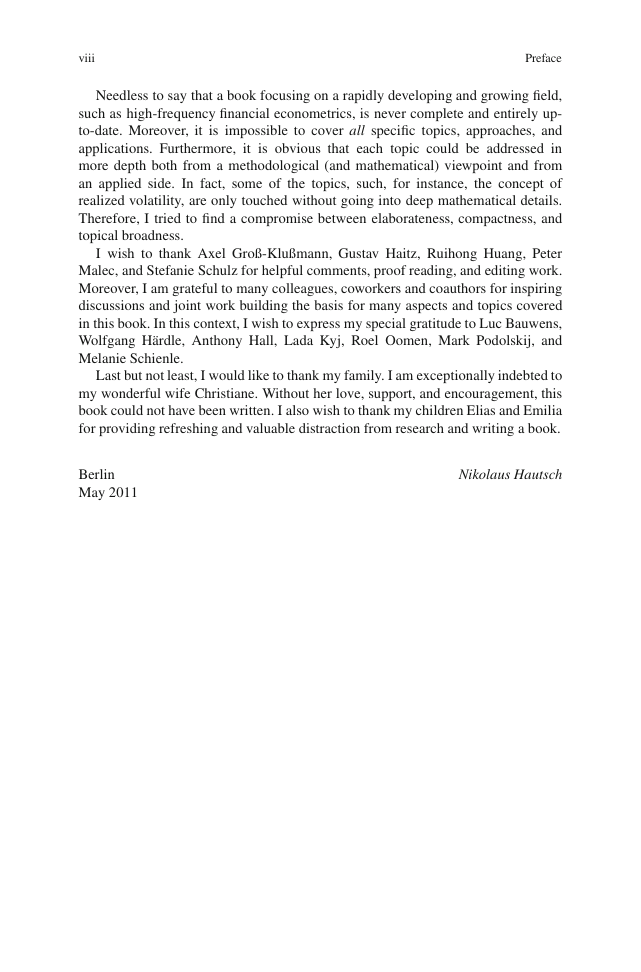
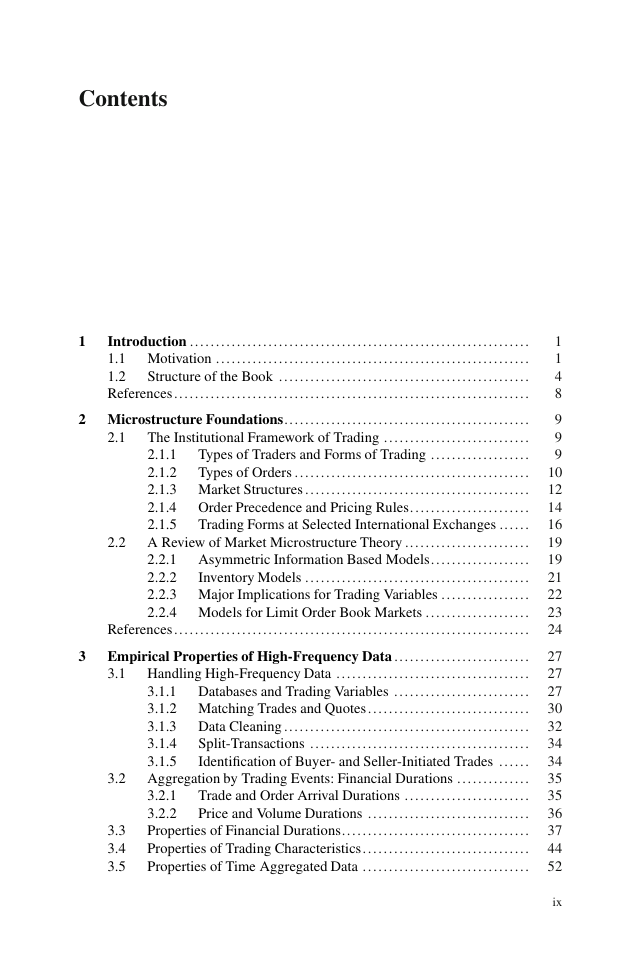









 2023年江西萍乡中考道德与法治真题及答案.doc
2023年江西萍乡中考道德与法治真题及答案.doc 2012年重庆南川中考生物真题及答案.doc
2012年重庆南川中考生物真题及答案.doc 2013年江西师范大学地理学综合及文艺理论基础考研真题.doc
2013年江西师范大学地理学综合及文艺理论基础考研真题.doc 2020年四川甘孜小升初语文真题及答案I卷.doc
2020年四川甘孜小升初语文真题及答案I卷.doc 2020年注册岩土工程师专业基础考试真题及答案.doc
2020年注册岩土工程师专业基础考试真题及答案.doc 2023-2024学年福建省厦门市九年级上学期数学月考试题及答案.doc
2023-2024学年福建省厦门市九年级上学期数学月考试题及答案.doc 2021-2022学年辽宁省沈阳市大东区九年级上学期语文期末试题及答案.doc
2021-2022学年辽宁省沈阳市大东区九年级上学期语文期末试题及答案.doc 2022-2023学年北京东城区初三第一学期物理期末试卷及答案.doc
2022-2023学年北京东城区初三第一学期物理期末试卷及答案.doc 2018上半年江西教师资格初中地理学科知识与教学能力真题及答案.doc
2018上半年江西教师资格初中地理学科知识与教学能力真题及答案.doc 2012年河北国家公务员申论考试真题及答案-省级.doc
2012年河北国家公务员申论考试真题及答案-省级.doc 2020-2021学年江苏省扬州市江都区邵樊片九年级上学期数学第一次质量检测试题及答案.doc
2020-2021学年江苏省扬州市江都区邵樊片九年级上学期数学第一次质量检测试题及答案.doc 2022下半年黑龙江教师资格证中学综合素质真题及答案.doc
2022下半年黑龙江教师资格证中学综合素质真题及答案.doc